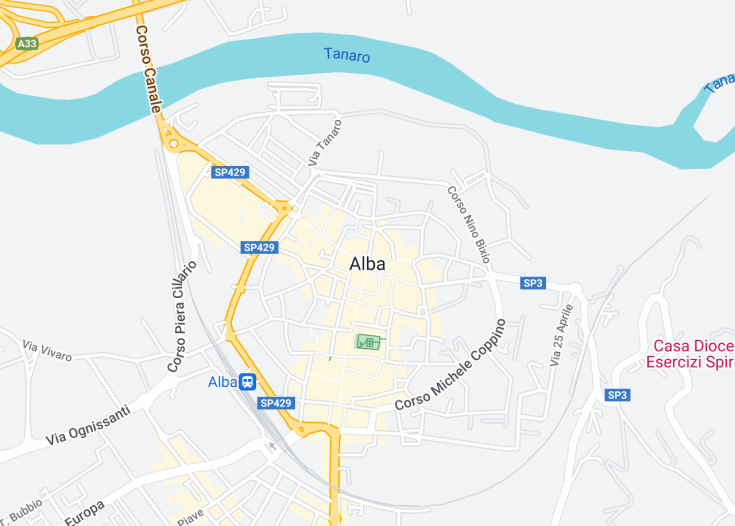Alba, a jewel of Italy’s Piedmont region, offers an enchanting blend of history, cuisine, and culture, making it a captivating destination for discerning travelers. Known for its truffles, fine wines, and medieval architecture, Alba draws visitors into its charming streets lined with historic buildings and bustling markets. The city serves as an ideal base to explore the Langhe wine region and promises an experience rich in gastronomy, heritage, and scenic beauty.
Consider visiting Alba during the autumn to participate in the famous Truffle Festival, which showcases the region’s culinary heritage and vibrant local culture.
Make time to wander through Alba’s ancient cobblestone streets, where a surprise awaits around every corner, from upscale boutiques to rustic osterias serving local wines.
Top things to do & see in Alba
Select the following sights and activities to discover best tickets and tours available in Alba.
Alba: The Heart of Piedmont’s Wine Country
| Country | Italy |
| Time in Alba | GMT+1 |
| Language spoken | Italian |
| Population | 31,500 (Source: ISTAT, 2021) |
| Currency | Euro (€, EUR) |
| Airports |
|
Located in the Piedmont region of northwestern Italy, Alba is a charming city renowned for its white truffles, fine wines, and historical sites. Surrounded by hills planted with vineyards, Alba plays a vital role in the production of Barolo and Barbaresco, two of the world’s most esteemed red wines. The city’s ancient origins are visible through its Roman ruins, medieval towers, and Renaissance buildings that adorn the old town. Each autumn, Alba celebrates its prized white truffles with the International White Truffle Fair, attracting gourmands worldwide. The aroma of truffles fills the city streets, blending with the scent of roasted hazelnuts and rich wines.
Where is Alba?
Nestled in the Langhe region of northern Italy, Alba is a scenic city surrounded by rolling vineyards and lush landscapes.
Distances:
| Route | Distance by car | Time by car |
| Milan to Alba | 90 mi (145 km) | Approx. 2 hours |
| Turin to Alba | 44 mi (71 km) | Approx. 1 hour |
| Genoa to Alba | 93 mi (150 km) | Approx. 2 hours |
What is Alba famous for?
Alba is famous for its prestigious white truffles and exquisite wines like Barolo and Barbaresco. The International White Truffle Fair and vibrant food culture make it a culinary hotspot.
History
Ancient Origins – Pre-Roman Times
Alba, situated in the Piedmont region of Italy, traces its roots back to pre-Roman times when it was inhabited by the Celtic-Ligurian tribes. The strategic location made it a focal point for both trade and warfare among the indigenous tribes.
Roman Era – 1st Century BC to 5th Century AD
The Romans established Alba Pompeia as a military camp around the 1st century BC, which soon evolved into a full-fledged colony. The town became an essential center for agriculture and commerce, well-known for its fertile lands and vineyards. The fall of the Roman Empire saw the decline of the city as it faced invasions and pillages.
Medieval Period – 6th to 15th Century
During the early medieval period, Alba emerged as a significant religious and military stronghold. By the 12th century, it was a free commune, actively engaged in the power struggles between the Holy Roman Empire and local lords. The city walls, parts of which still stand today, were built during this era to defend against invasions.
Early Modern Period – 16th to 18th Century
Alba saw economic and cultural development during the Renaissance, with the refinement of its agricultural practices, particularly in viticulture. The period also marked the construction of several baroque-style buildings and churches, enhancing its architectural heritage.
Industrial Age to Modern Day – 19th Century to Present
The 19th and 20th centuries marked industrial growth and modernization for Alba. Today, it is celebrated globally for its white truffles, wines, and vibrant gastronomy culture. The city blends its illustrious past with a thriving present, making it a key cultural and economic hub in Piedmont.
Visit Alba
What to see and do in Alba
Alba, Italy, beckons visitors with its rich history, distinctive gastronomy, and breathtaking landscapes. Wander through the Centro Storico with its medieval towers, explore the Alba Cathedral, and visit the Federico Eusebio Museum to delve into local archaeology and history. Discover the surrounding Langhe hills, a UNESCO World Heritage site, known for exquisite wines and panoramic views.
- Walk through the weekly truffle market.
- Taste Barolo and Barbaresco wines directly from local vineyards.
- Join a guided truffle hunting excursion.
Annual Festivals in Alba
Alba is renowned for the Alba White Truffle Festival held every October and November, attracting gourmet enthusiasts worldwide. Additionally, the Vinum Wine Festival in April showcases local wines, and the Palio di Alba, a historic horse race, takes place every September, reviving ancient city rivalries.
Best time to visit Alba
The ideal times to visit Alba are during spring and autumn. Spring offers the Vinum Wine Festival and vibrant landscapes, while autumn provides the opportunity to experience the famous White Truffle Festival amid the colorful foliage of the vineyards.
Is Alba worth visiting?
Alba is undoubtedly worth visiting for its unique blend of historical richness, culinary excellence, and natural beauty. The city offers a glimpse into Italy’s past and present through its well-preserved historical sites and thriving truffle and wine culture. Whether you are a history buff, a foodie, or a nature lover, Alba provides an enriching and delightful experience that caters to diverse interests.









